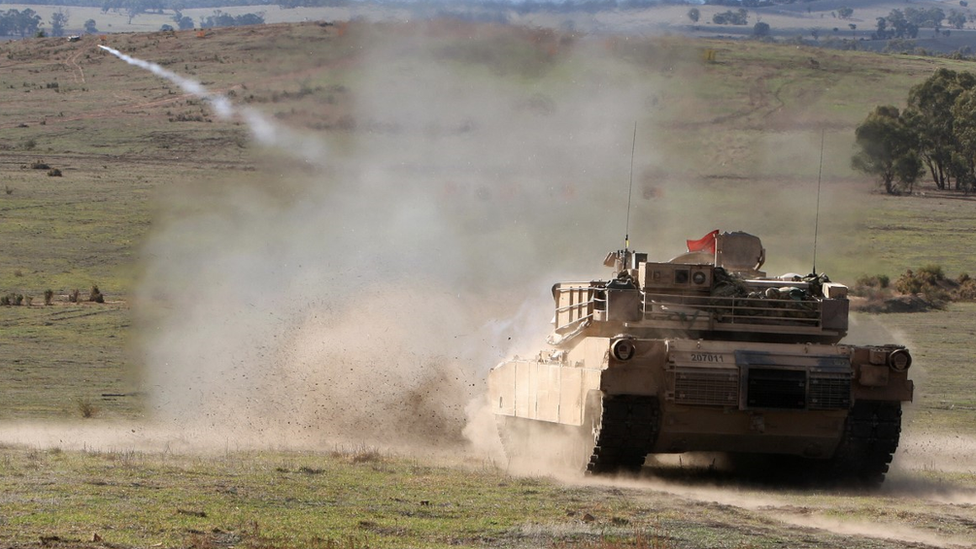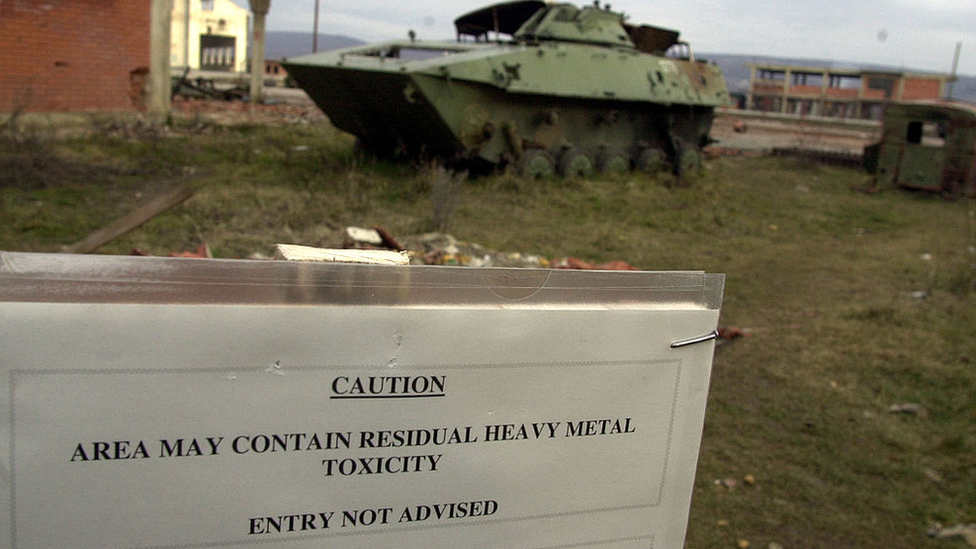Depleted uranium shells: Why are they used and are they dangerous?
- Published

The US is sending depleted uranium shells to Ukraine, to be used with the Abrams tanks it is also supplying.
The shells can pierce conventional tank armour, but there are some concerns over whether depleted uranium is harmful.
What is depleted uranium?
Depleted uranium is naturally-occurring uranium which has been stripped of much - but not all - of its radioactive matter.
It is a by-product from the process which prepares uranium for use in nuclear power plants and nuclear weapons.
Why do some weapons use depleted uranium?
Uranium is a very dense metal, and depleted uranium can be put on the tips of tank shells, bullets and mortar rounds to increase their ability to penetrate targets.
Depleted uranium shells sharpen on impact, which further increases their ability to bore through armour, and they also ignite after contact, external.
It can also be used to reinforce tank armour.
The UK Ministry of Defence (MoD) says depleted uranium missiles were developed by the US and UK in the 1970s.
They were first used in the Gulf War in 1991, and then in Kosovo in 1999, and during the Iraq War in 2003.

The US used depleted uranium weapons during the 2003 Iraq War
How dangerous is depleted uranium?
The International Atomic Energy Authority (IAEA) says depleted uranium has "chemical and radioactive toxicity", external, but is considerably less radioactive than naturally-occurring uranium.
"The fear is that if depleted uranium shells land on the ground, they may contaminate the soil," says Dr Marina Miron, from Kings College London. "That is why the US and its Nato allies sparked controversy when they used them in Kosovo."
The UN General Assembly ordered a review into the health effects of depleted uranium weapons in 2007, and international bodies have since carried out several further reviews.
In 2016 the UN's Scientific Committee on the Effects of Atomic Radiation (UNSCEAR) found no significant poisoning was caused by exposure to depleted uranium, external.
However, the IAEA warns there could be a risk to individuals who handle fragments of depleted uranium rounds.

Kosovo residents were warned of depleted uranium risks after the 1999 war
A study published in the journal Environmental Pollution in 2019 suggests there may be links between the use of depleted uranium weapons and birth defects, external in Nasiriyah, in Iraq.
A 2022 UN Environment Programme (UNEP) report, external said it was concerned about possible depleted uranium use in Ukraine, warning it can cause "skin irritation, kidney failure and increase the risks of cancer".
"The chemical toxicity of depleted uranium is considered a more significant issue than the possible impacts of its radioactivity," it says.
Are depleted uranium rounds legal?
Depleted uranium weapons are not considered nuclear weapons, and no specific treaty bans their use.
However, a group called the International Coalition to Ban Uranium Weapons wants them to be made illegal over claims that they "prolong war into indefinite time" as a result of long-term environmental and health effects, external.
The MoD has said that under Article 36 of the First Protocol of 1977 Additional to the Geneva Conventions of 1949, depleted uranium shells are "capable of being used lawfully in international armed conflict", external.
Which weapons are being sent to Ukraine?
The UK has already supplied depleted uranium shells to Ukraine's armed forces, external, to use with the Challenger 2 tanks that it has sent.
The MoD said the shells would enable Ukrainian tank crews to fire on enemy targets from greater distances, external, reducing their exposure to counter-fire.
Russia has condemned the US and the UK for sending depleted uranium weapons to Ukraine. President Vladimir Putin said they contained a "nuclear component", and that he would be "forced to react" to their use.